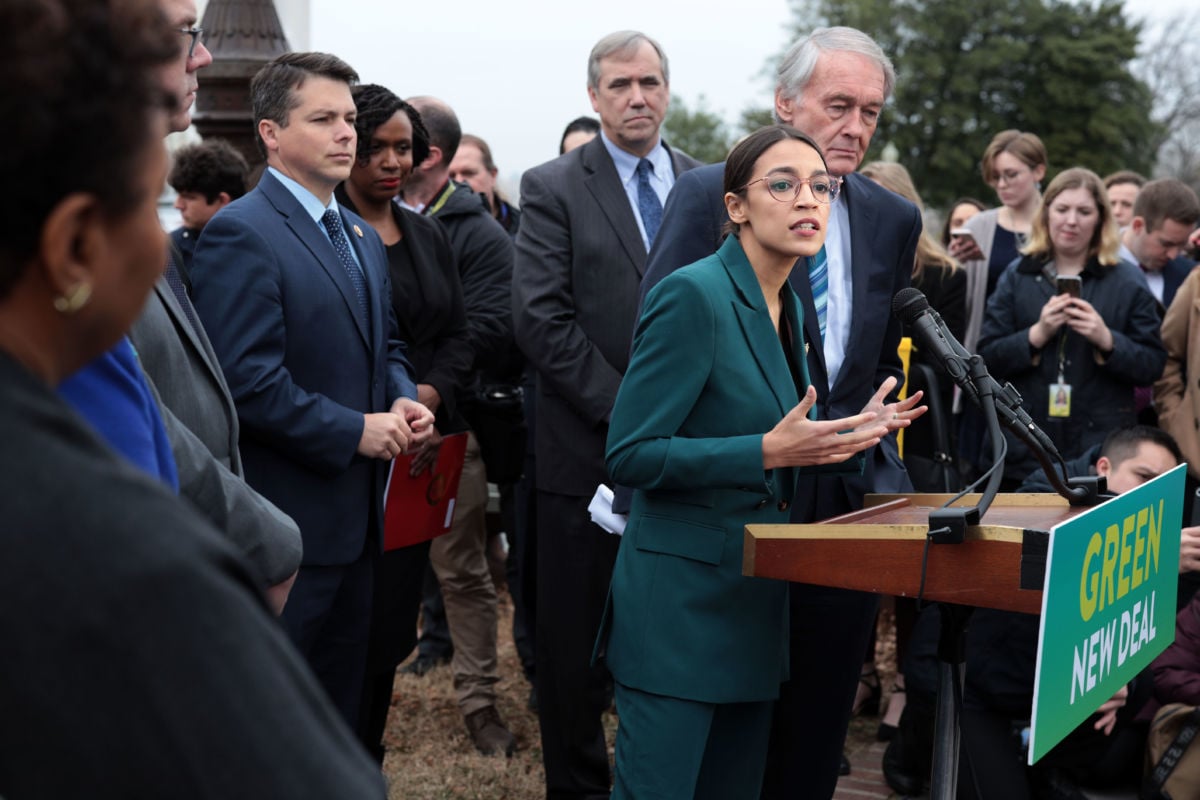Rep. Alexandria Ocasio-Cortez (D-New York) and Sen. Edward Markey (D-Massachusetts) led the rollout of the first resolution laying the foundation for the Green New Deal. It is one of several unprecedented efforts demanding that the government take aggressive action in the face of climate change.
Though ideas for a Green New Deal have been kicking around for over a decade, Ocasio-Cortez catalyzed the framework after making it a cornerstone of her campaign. Defying skepticism that she would be able to pull centrist heavyweights on board, she introduced the proposal with wide party support just over a month after taking office. The nonbinding resolution included 64 House and nine Senate original co-Sponsors, including presidential hopefuls Sen. Cory Booker, Sen. Kirsten Gillibrand, Sen. Kamala Harris, Sen. Bernie Sanders and Sen. Elizabeth Warren. Despite a derisive response from House Speaker Nancy Pelosi, this consensus effectively cements the Green New Deal as a defining policy for the Democratic agenda.
The resolution is one of the strongest rebukes to President Trump, who boasted of deregulation and crowned the US the “number one producer of oil and natural gas in the world” during his State of the Union address this week. The preamble to the Green New Deal resolution starkly lays out the impacts of climate change in the US. Drawn from previous US and UN climate reports, the resolution restores the authority of the scientific community as the Trump administration scrubs climate data and prohibits the very mention of the term.
As a blueprint for collective action on climate change, the Green New Deal has attracted a great deal of enthusiasm and reserved support, with crucial details still to come. The proposal raised eyebrows with its ambitious 10-year plan to cut carbon emissions by 2030, transition to renewable energy sources, and invest heavily in job creation and infrastructure. It amounts to nothing short of a wholesale transformation: The Green New Deal framework rests on the idea of a just economy.
The resolution rejects the piecemeal carrot and stick approaches of previous Democratic legislation — the carbon tax cap-and-trade policy. It instead focuses holistically on the right to a clean and sustainable climate. It emphasizes the effects of climate change on frontline and vulnerable communities and recognizes the role of systemic inequalities and injustices. It ties together far-reaching ideas around sustainable work and wages, unionization, universal health care, housing and trade. In an era of political gridlock, these goals seem impossible but Ocasio-Cortez has placed them in the tradition of other great policy mobilizations, calling it “our moonshot.”
The Green New Deal’s vision of a just economy rings most powerfully when understood in concert with the rallying calls of youth movements demanding that the government respond to the urgency of climate change. In 2015, 21 young adults filed a landmark lawsuit — Juliana vs. United States — against the Obama administration, compelling the government to act. They argued that the government had violated their constitutional rights by ignoring decades of knowledge about the substantial harm and damage caused by fossil fuels, which they will bear the disproportionate burden of mitigating.
It is a powerful statement from a younger generation that has proven adept and undeterred at tackling entrenched issues like gun control and climate change. The Sunrise Movement, a movement of young, diverse activists, formed in 2016, has quickly become a political force, taking more direct action to hold politicians accountable and push action on climate change, including through a Green New Deal framework.
Following the Sunrise Movement activists’ protest in Pelosi’s office during the battle for her speakership, Ocasio-Cortez invited them to help her draft her proposal to create a new House select committee on climate change — announced concurrently with the Green New Deal as the House Select Committee on the Climate Crisis. Sunrise Movement activists accompanied Ocasio-Cortez as she announced the Green New Deal, reflecting her statements that social movements should be seen as a “moral compass.”
The Sunrise Movement’s tactics to occupy the offices of undecided Democrats may be seen by some as risky. But this strategy, which stands in the proud lineage of daring environmental direct action, may finally force legislators to acknowledge a previously muted constituency. The youth vote will be a decisive voice at the ballot box in 2020, and the Sunrise Movement activists have made it delightfully clear that politicians can either get on board or “fade into oblivion.”
Climate legislation until now has been hampered by a creative failure to work within the confines of the existing political structure or imagine a new one. While the Green New Deal has attracted doubt from some mainstream quarters for its idealism, it has already sparked a conversation about what the government can achieve — and has in the past.
Ushered in through the leadership of Ocasio-Cortez, the Green New Deal is perhaps most notable for offering a hand to youth movements that have taken up the fight with creativity and vigor. Uniting generations, the Green New Deal has become not just a revolutionary vision of government but a multigenerational fight.
Join us in defending the truth before it’s too late
The future of independent journalism is uncertain, and the consequences of losing it are too grave to ignore. To ensure Truthout remains safe, strong, and free, we need to raise $29,000 in the next 36 hours. Every dollar raised goes directly toward the costs of producing news you can trust.
Please give what you can — because by supporting us with a tax-deductible donation, you’re not just preserving a source of news, you’re helping to safeguard what’s left of our democracy.
